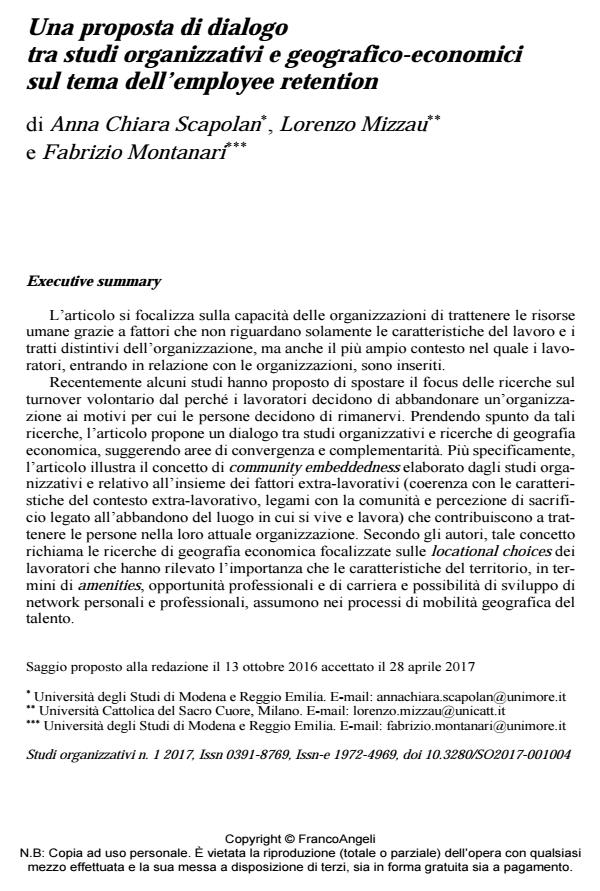Una proposta di dialogo tra studi organizzativi e geografico-economici sul tema dell’employee retention
Journal title STUDI ORGANIZZATIVI
Author/s Anna Chiara Scapolan, Lorenzo Mizzau, Fabrizio Montanari
Publishing Year 2017 Issue 2017/1
Language Italian Pages 21 P. 89-109 File size 239 KB
DOI 10.3280/SO2017-001004
DOI is like a bar code for intellectual property: to have more infomation
click here
Below, you can see the article first page
If you want to buy this article in PDF format, you can do it, following the instructions to buy download credits

FrancoAngeli is member of Publishers International Linking Association, Inc (PILA), a not-for-profit association which run the CrossRef service enabling links to and from online scholarly content.
This article reviews the literature on job embeddedness (i.e. organizational and community embeddedness), which has been extensively analyzed as a determinant of voluntary turnover, and proposes a dialogue between organization (HRM) studies and economic geography (urban studies). By clarifying how the focus moved from the issue of why people leave organizations to why people remain, it analyzes the overlaps and complementarity between the community embeddedness literature and the literature on workers’ locational choices in economic geography. Results point to the importance of investigating off-the-job factors in understanding why people are retained into organizations, and of taking into appropriate consideration the intermediating role that organizations could have for enhancing the retention capacities of territories. Research and managerial implications are discussed.
Keywords: Embeddedness, turnover, retention, Human Resource Management, economic geography.
- Rethinking Work: Pathways and Practices in Business and Society. Introduction to the Special Issue. Luigi Moschera, Mario Pezzillo Iacono, Giovanna Lo Nigro, Laura Lucia Parolin, in STUDI ORGANIZZATIVI 2/2019 pp.9
DOI: 10.3280/SO2018-002001 - The Role of Solidarity in Diversity Management Practices: A Challenge for Social Innovation in Organisations Davide Bizjak, Guglielmo Faldetta, Luigi Maria Sicca, in STUDI ORGANIZZATIVI 2/2019 pp.130
DOI: 10.3280/SO2018-002006 - An aesthetic account of space: A report on recent developments in organizational research Federica De Molli, in STUDI ORGANIZZATIVI 1/2019 pp.38
DOI: 10.3280/SO2019-001002
Anna Chiara Scapolan, Lorenzo Mizzau, Fabrizio Montanari, Una proposta di dialogo tra studi organizzativi e geografico-economici sul tema dell’employee retention in "STUDI ORGANIZZATIVI " 1/2017, pp 89-109, DOI: 10.3280/SO2017-001004